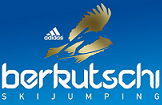 Ski jumping hill dictionary
Ski jumping hill dictionary
Overview:

Advertisement:
Dictionary:
 Athletes village
Athletes villageIs mostly located near the ski jump head. Cabins or containers are giving store options for the teams’ equipment and (ski) preparation. It is also a popular area for the warm-up and imitation jumps.
 Boards
BoardsBoards are the borders at the inrun, landing hill and outrun. Usually, they are made from wood. In the outrun, they are also advertising space for the various sponsors of the competitions and hosts (ski federations and clubs).
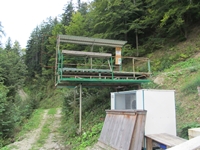 Coaches tower
Coaches towerThe coaches tower or platform usually stands close to the table. There, the coaches stay during the competitions in order to signal start clearance to their ski jumpers, which is usually done by waving a small flag. From the coaches tower, the trainers have a perfect view on take-off and flight transition, which they often video record for later analysis of the jumps.
Die construction norm for ski jumping hills is a document released by the FIS, that specifies regulations regarding geometric elements of a ski jumping hill and constructive requirements. To obtain FIS homologation for a ski jumping hill, the hill profile needs to fulfil those regulations of the construction norm. They frequently are updated to make sure that the flight curve, which changes depending on material enhancements and developing jumping style, remains safe.
Ski jumping competitions are impossible to hold without a distance measuring that also helps translating the distances into distance points. This is done either manually by distance judges that stand next to the landing zone and are guided by the distance signs or via a video measuring system. Even though this video measuring system is in use at World Cups and big events, distance judges are still in charge in case technical issues occur.
The total points of a jump consist of the sum of distance points, style points and wind and gate compensation. In order to do that, every jumped distance gets converted into distance points. For reaching the K-Point distance usually 60 points are awarded, only on flying hills it is 120 distance points. Depending on jumping hill size, a certain amount of points per meter jumped is added or substracted. On normal hills the meter value is 2.0, on large hills 1.8 points and on flying hills 1.2 points.
 Distance signs
Distance signsDistance signs are mounted on all ski jumps at the boards alongside the landing zone. These ensure the manual distance measuring by distance judges and also marking certain distances on the landing hill in the winter with food coloring or brushwood in and on the snow.
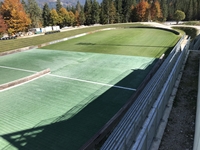 Fall line
Fall lineThe fall line marks the end of the landing hill transition and the start of the outrun. Especially for the judges, this line is a crucial point of the hill. In case they noticed a mistake in the jump of the athlete, they are supposed to deliver lower style points. A fall or a mistake behind this line, that is a white line on the mattings and in winter marked by brushwood, shall not affect on the judge points.
The flight curve describes the ballistic curve that a ski jumper travels through air from take-off at the table to landing in the landing zone. Factors that influence it are mostly the parameters of the hill profile, the individual take-off (power, speed, height, direction) and in-flight behaviour of the athletes. The construction norm gets updated frequently in order to flatten the flight curve as much and as safe as possible, so that the jumpers maintain at a low height above the landing hill.
 Floodlights
FloodlightsAs well as in other sport stadiums, the purpose of floodlights are to enlarge the usage time of a ski jumping hill even on short days or in the darkness. Floodlights are nowadays standard at the World Cup-hills, next to the inrun and landing hill.
 Hill certificate
Hill certificateThe "Certificate of Jumping Hill", in short usually called "hill certificate", documents the geometric parameters of the hill profile. The certificate is part of the homologation of every ski jumping hill and is issued by the FIS. Usually, it is issued only for 5 years and needs to be re-validated and re-newed regularly through inspections, since the requirements for ski jumps are constantly changing. If a hill does not have a certificate, it must not be used for international competitions.
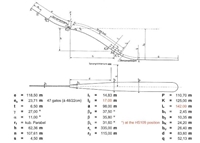 Hill profile
Hill profileThe Hill profile describes the characteristics of ski jumping hills and is part of every homologation. For architects and builders, the hill profile is the draft for building a ski jumping hill. The hill profiles need to be made according to the constuction norm, especially when it comes to re- or new-building a ski jumping hill. All the geometric values of a Hill profile are put into the hill certificate.
 Hill Size
Hill SizeBack in the day "jury distance", is the main indicator for a size of a hill (see down below). Usually, this distance is marked by a red line. According to FIS Race Director Walter Hofer the hillsize defines the jumping hill size at the following angles of the landing slope: "On normal hills at 32 degrees, on large hills at 31 degrees and on ski flying hills even more down below, approximately at 28 or 27 degrees."
 Homologation
HomologationA homologation is necessary for each hill, where FIS-competitions are supposed to be held. It is usually made during a hill inspection in order to check the parameter of the hill profile according to the construction norm. If a hill gets a certificate, a hill is officially suitable for international competitions.
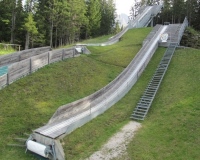 Inrun
InrunEvery jump on a ski jumping hill starts in the inrun. The jumpers take a (short) seat on the start bar at the start gate, leave it after the start approval in order to speed up the inrun track and catapult themselves at the table at the end of the inrun in the air. The inrun itself can either be a natural slope on a hill or might be firmed up by an inrun tower, which are mostly made of steel or ferroconcrete earlier and on smaller hills of timber.
 Inrun angle
Inrun angleThe inrun angle is the angle of the upper inrun part, above the inrun radius. It varies depending on size of the ski jump and geological circumstances. World Cups usually have an inrun angle between 30° und 35°, but maximum 37°.
An inrun cooling for the inrun track made of ice and snow gets more and more important. A "breaking" inrun track is undoubtely a safety issue for ski jumpers and impedes a regular competition. So, there are systems that are installed below the snow or ice track in the inrun and shall avoid a melting track. Also artificial tracks have a cooling system.
 Inrun length
Inrun lengthThe inrun length is the distance of the inrun track from the highest or chosen start gate to the table. The longer the inrun length, the higher the inrun speed and possibly also the jump distance.
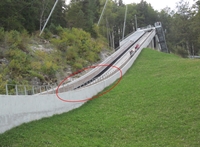 Inrun radius
Inrun radiusThe inrun radius is the term for the transition of the upper part of the inrun to the table. Earlier, this part was a segment of a circle with a steady curve. Nowadys, it is a cubic parable, that does not have this steady curve and allows a smoother transition from radius to the table.
The inrun speed is the measured speed a jumper has at the end of the inrun right at the take-off.
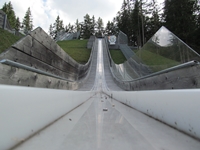 Inrun track
Inrun trackThe jumpers go through a prepared track in the inrun to the table. Either, it is an installation in the inrun or gets prepared with an ice block or of snow. Materials for an inrun track could be: Porcelain/ceramic, alu, steel or plastic mattings (summer) or ice, (artificial or natural) snow or an artificial ice track in the winter. At most of the hills, that are used in international competitions, an inrun cooling system is installed.
Depending on her size, ski jumping hills can be put into different categories. In total, there are five of those categories, that are separated by the hillsize, respectively K-Point:
| Category | Hillsize HS | K-Point |
|---|---|---|
| Small Hills | to 49 m | to 44 m |
| Medium Hills | 50 to 84 m | 45 to 75 m |
| Normal Hills | 85 to 109 m | 76 to 98 m |
| Large Hills | 110 to 145 m | 99 to 130 m |
| Ski Flying Hills | from 185 m | from 166 m |
 Jury tower
Jury towerThe jury tower is located on one of the sides next to the landing hill and is the work place for the Chief of Competition, the Assistant Race Director (man on the start lights) and the judges who evaluate each jump with style points.
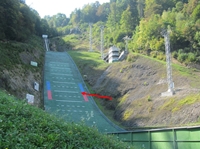 K-Point
K-PointThe K-Point, earlier construction- or calculation-point or critical point, is one of the main parameters for the size of a ski jump and the type of hill profile. It is indicated by a (red) line on the landing hill. It is the key for the calculation of the distance points.
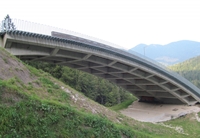 Knoll
KnollThe knoll is the first part of the landing hill and is, depending on its shape, more or less difficult to fly over. The knoll can be an artificial construction, but mostly it is a flattened natural hill.
 Landing angle
Landing angleThe landing angle describes the inclination of the hill, where the jumpers land on the landing hill. At the K-Point it is about 34°-36°, but varies depending on size of the jump. A general rule is: The longer the jump, the smaller (flatter) the angle and the harder to land safely due to a rising landing pressure.
 Landing hill
Landing hillThe landing hill consists of knoll, landing zone and landing radius and is, besides the inrun, the second main part of a ski jumping hill. Jumpers fly above and land on it. Depending on the jump size, it is more or less steep (see landing angle) and allows the distance measurement.
 Landing transition
Landing transitionThe landing transition starts at the end of the landing zone, at the Hill Size and ends at the beginning of the outrun at the fall line. Earlier, the landing transition was indicated in the hill profile similar to the inrun radius with a segment of a circle, but now with a cubic parabel.
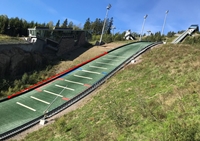 Landing zone
Landing zoneThe landing zone is the part of the landing hill, where the jumpers usually land and which brings them distance points. This starts not right after the table, but at the bottom of the knoll and is indicated by a circle curve in the hill profile. The beginning of the landing zone - where the hill has its steepest part with maximum 37° - is featured in the TV-graphics as well as the K-Point and the Hill Size.
 Lift
LiftNo matter if cabin cars or chair lifts: Lifts have raised comfort for athletes, coaches and officials, and also visitors significantly. There is no need to use the stairs anymore to come from the bottom to the head of the ski jumping hill.
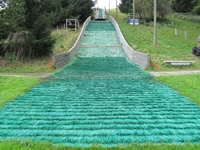 Mattings
Mattings(Plastic) mats or mattings are installed on the landing hill of many ski jumping hills and allow ski jumping without snow. These are mostly made of green plastic and need to be watered, so that the jumpers can train and compete on the ski jumping hills.
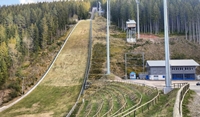 Natural ski jump
Natural ski jumpA natural ski jump is a ski jump, whose main construction (inrun and knoll, respectively landing hill) does not contain any artificial elements. Examples for this kind of ski jumps were those in Engelberg and at Kulm before their last conversions as well as the Hochfirstschanze in Titisee-Neustadt, which still is a natural ski jump.
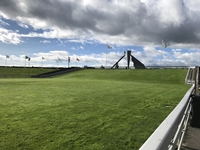 Outrun
OutrunThe outrun is the part of the ski jumping hill, jumpers reach after passing the fall line and finally stop. Usually, it is a flat, but at some hills, e.g. Bergisel or Holmenkollen (heavily) rising, slope.
 Ski flying hills
Ski flying hillsSki flying hills are the biggest hills in the world. There are four of those (in Vikersund, Planica, Bad Mitterndorf and Oberstdorf) who have a vaild certificate. Harrachov's ski flying hill does not have a certificate since 2019 anymore. Another one, out of use for several years now, is located in Ironwood. The term "ski flying hill" was officially established in 1972 when the FIS decided to inaugurate ski flying world championships. Practically, ski flying as a special discipline in ski jumping, exists already since the world record hunt in 1930's. Since 1962, there is also the international ski flying association KOP, whose name was composed from the three ski flying places that existed back then (Kulm-Oberstdorf-Planica).
 Ski jump head
Ski jump headSki jump head is a common term for the highest/most far away point of the ski jumping hill (looking from the bottom) and means the back of the inrun tower or, at natural ski jumps the back end of the inrun. In some cases, it might also mean the athletes village.
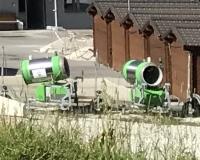 Snowmaking
SnowmakingSnowmaking, also called snow guns or cannons, have become more and more important in times of snow lean winters. In case of lack of snow, snowmakers are highly important in order to secure competitions and to prepare the landing hill. Some of these machines are even capable to produce snow at temperatures above ten degrees Celsius - only water is required for that.
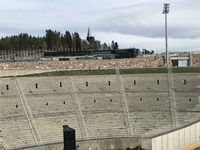 Spectators area
Spectators areaThe spectators area is usually located next to the outrun. Sometimes it is just a flat area, a natural or artificial stand. At some locations there is even a stadium/arena construction (like in Oberstdorf or Garmisch-Partenkirchen) or a cauldron (Innsbruck or Oslo), where spectators also find space next to the landing slope.
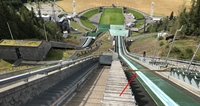 Start bar
Start barStart bar, sometimes also called "Happle bar", named after its inventor Wolfgang Happle, is part of ski jumping since the early 1990's. Before the start gates were invented, jumpers either started from the top of the inrun or found start positions a bit down the inrun from the sides. Nowadays a transportable or riding start bar gets installed at the chosen gate and jumpers sit down there before starting their jump.
 Start gates
Start gatesThe start gates are located in the upper area of the inrun and allow the jury or coaches to vary the inrun length. The jumpers sit down on the start bar. At the start of every competitiona, the inrun length is defined by the choice of a certain start gate. Since the wind and gate compensation was invented in the season 2009/2010, the inrun length can be changed during the competition.
The start lights in ski jumping have quite some similarities to the traffic lights. There are also three colors: Red, yellow and green. If the lights show red, the inrun is closed and the jumpers are also not allowed to sit down on the start bar start bar. If the light shows yellow, the jumpers should sit down on the start bar and wait for the change of light. The duration of the yellow phase is maximum 45 seconds. In case the light shows red again, the jumpers are supposed to leave the start bar. In case the light shows green, the jumpers have ten seconds to start their jump either by themselves or after a sign by their coach. In case this process takes longer, the athlete gets disqualified automatically.
In the beginnings of ski jumping, in the late 19th and the early 20th century, jumpers were judged only by their style in the air! Nowadays, the total points for a jump consists of distance points, style points and compensation points. At international competitions, there are five judges who follow the jumps from the judges tower and deliver points according special criteria for the flight, the landing and skiing after landing (until the jumpers passed the fall line. A perfect jump, style-wise, can score a maximum 20 points. The highest and the lowest style points of the five get erased, while the other three get added to a total sum. Which means: The maximum sum for style points can be 60 points.
 Table
TableThe take-off table is the final part of the inrun. Here, the jumpers have to start and execute the take-off, which is essential for a high distance. Therefor, timing, power and direction are crucial.
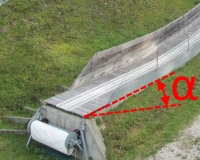 Table angle
Table angleThe table is inclined a bit down - and not up, like on a ramp! The angle of inclination is about 10° and is - next to the table length - another important character trait of the hill profile, that influences the take-off-behaviour.
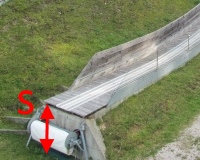 Table height
Table heightThe height of the table is the vertical height of the edge of the table and the beginning of the landing hill. It is different on each hill and an important factor for the flight curve. In earlier days, there existed even table heights of more than 5 meters on large hills. The result of that were high and dangerous flight curves. Nowadays, the table height is about 3-4 meters.
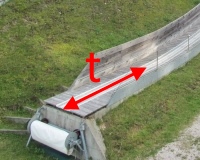 Table length
Table lengthThe length of the table is another detail of the hill profile, besides the table angle, that effects the jumpers' behaviour at the take-off. On large hills it is mostly 6-8 meters. If the table is longer than usual, jumpers tend to start their jump too early. If it is shorter, they often jump too late.
 Video walls
Video wallsVideo walls, which are located at the outrun or next to the landing zone, shall inform the spectators about the current standings and show the jumps as well as replays, to display those parts of the jump spectators possibly could not watch from their position.
 Warming room
Warming roomThe warming room, where jumpers are staying before their jumps, is mostly located in the inrun tower or a building at the ski jump head. In almost every case there is also a TV screen, so that they can follow the ongoing competition.
Was inaugurated after a short test phase by the end of the 2009/2010 season and enhanced the level of attraction for TV spectators by far. Since this invention, competitions where the inrun length inrun length needed to be changed, did not have to be restarted anymore. With this tool, the jury can react on various condition changes. In case the inrun length gets reduced, the jumper get plus points since the reduced inrun speed is a disadvantage. On the opposite: An increased inrun length inrun speed is an advantage, following that the jumpers get minus points. The same principle goes for the wind directions: Tail wind, which pulls the jumpers down brings them plus points, head wind which is carrying the jumpers brings them minus points. Compensation points are added to the distance- and style points to calculate the total points for a jump.
Digital meters for wind direction and speed have to be placed in regular intervals on both sides of the landing hill during international competitions. At the start of a competition, an apporpriate Start gate and a wind corridor are chosen. In case the measured wind values are outside of the corridor, the Start lights shall not turn green. In addition to that, the average values of all meters are used for the calculation of the Wind compensation.
 Wind net
Wind netThe wind net is very useful installation, especially in areas with strong winds, in order to raise the security and fairness for jumpers during training and competition. In most cases, wind nets are installed on one or even both sides of the landing hill at the knoll- and inrun table-area, due to the fact that this is the point where jumpers suffer the most from (heavy changing) side winds.



 Dresden
Dresden Les Diablerets
Les Diablerets  Virolahti
Virolahti Kopaonik
Kopaonik Kamensk-Uralsky
Kamensk-Uralsky Lovrenc na Pohorju
Lovrenc na Pohorju 



